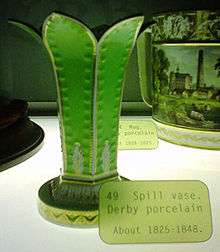Spill vase

A spill vase is a small cylindrical vase or wall-hanging vase for containing splints, spills and tapers for transferring fire, for example to light a candle from a lighted fire. From the documentary record, they probably date back to the 15th century. They might be made of wood, iron, porcelain, pottery, brass and even wall paper. There are also some examples made in glass, although these are mostly limited to the 1840s-50s.[1]
Purpose
A spill vase was usually kept on the mantelpiece and was filled with rolled paper tapers or very thin wood sticks, called "spill". Spill was used to transfer fire from the fireplace to candles, lamps, a pipe or a cigar. Commercial matches, which first surfaced in England during the 1820s,[2] were a relatively expensive commodity until the late 19th century, and spill was therefore a more cost effective solution.
Design
Some examples of spill vases have a rectangular holder for a matchbox, which allowed the user to light a single splint, or sliver of wood with the match and use the spill to transfer the fire to several candles.[1]
Decline
From 1860-65 there was a huge transitional period in the evolution of lighting and accessories.[1] Later, with the spread of electricity,[3] spill vases gradually became redundant, as people relied less on fire for lighting. However they later became expensive collectibles on the antiques market.
Agatha Christie refers to spill vases in her story "The Mysterious Affair at Styles" thus: "Poirot had walked over to the mantel-piece... his hands, which from long force of habit were mechanically straightening the spill vases on the mantel-piece, were shaking violently."
References
- 1 2 3 "Early American glass spill holders" http://www.patternglass.com/Form/spill/spills.htm
- ↑ "Match" Encyclopaedia Britannica. http://www.britannica.com/EBchecked/topic/368955/match
- ↑ "The History of Electricity - NEED" http://www.need.org/needpdf/infobook_activities/IntInfo/Elec3I.pdf